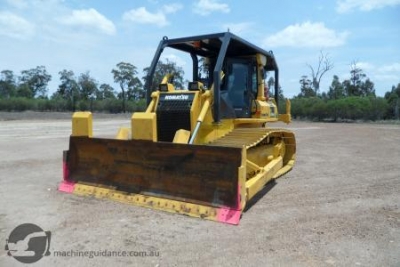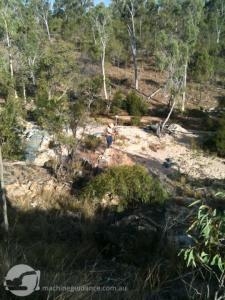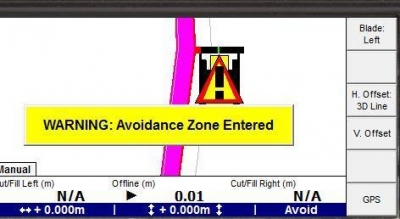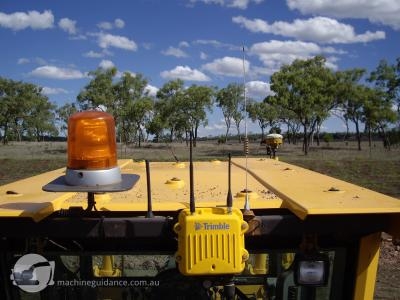
Overview of Machine Guided Construction

Overview of Machine Guided Construction (2)
Machine guided construction refers to the use of construction plant equipped with machine control technologies to compliment or replace traditional survey stakeouts methods.
Machine control involves the integration of survey positioning devices (most commonly using GPS) with construction machinery. Machine control devices use real-time position data and survey design information to instantly determine a machine's current location relative to a desired position. The difference is then displayed inside the machine cab allowing the operator to easily and efficiently determine what is required to create the intended design on the ground.
Machine control technologies are essentially an extension of traditional survey tools. Over time, inventions have appeared that have made a surveyor's job not only easier but much more accurate. Survey software has become more user-friendly and intuitive allowing for efficient and widespread field use, including the integration into construction machines.
These days machine guided construction is heavily used throughout the Australian civil construction and mining industries. Opportunity for practical ways to integrate this technology within other industries are yet to be fully discovered. One such opportunity exists for the pipeline industry and in particular the Clear and Grade (C&G) construction process.
When a pipeline alignment is issued for construction it is usually accompanied by a Right-of-Way (ROW). The ROW term refers to the boundary extents for which all related pipeline construction must be contained. The first pipeline construction process involves clearing the corridor of vegetation and then grading the topsoil into stockpiles within the ROW ready for re-use by the rehabilitation crews after pipe construction. This first construction process is performed by the 'Clear and Grade' crew most commonly using dozers, graders, excavators and/or mulchers. Much of this equipment is equipped with scrub canopies to protect the machinery from falling timber.

Traditional C&G Procedure

Traditional C&G Procedure (2)
Being the first step in the pipeline construction process, the traditional clear & grade process relies on design setout by survey crews prior to entering the work zone. The traditional survey process for clearing and grading ROW corridors most commonly involves a survey field team, GPS rover with base station equipment and survey stakes.
After receiving and/or digitising a design file, the ROW is loaded into a surveyor's GPS rover for field use. If not already available, the surveyor then establishes GPS base station coverage across the new work zone to commence staking the design.
Survey staking is generally a 2 or 3 man process. A surveyor will walk through the uncleared field and locate staking points at consistent intervals of approximately 100 metres in open country and 25 metres or less in dense vegetation. Additional points are marked at any changes of direction and Right of Way intersections.
Aiding the surveyor are 1 or 2 survey assistants / chainman. The assistants place stakes at the marked points and use different colours of flagging to indicate what side of the ROW boundary the stakes relate too. Additional flagging may be placed above and between the surveyed stakes for construction visibility. While the assistants may be able to drive within some uncleared ROW's they will regularly be required to walk the equipment into the correct locations, often over several trips.
Upon finishing a section of ROW, the surveyors will show the C&G supervisor and operator(s) the design stakeouts and provide any further explanations as required before continuing on the next section of setout. It is at this point that the C&G construction operation can commence.

Machine Guided C&G Procedure
The C&G machine guided procedure would commence in the same way as the traditional process with a design file being received and/or digitised by surveyors prior to field use. Similarly, if not already available the GPS base station coverage would still requires establishment. When available, the ROW design would be sent to the field but with this new procedure it would be loaded into the survey GPS rover as well as directly into the machine control cab-mounted display.
And this is where the main procedural changes would commence. By integrating the survey tools with the construction machinery, the machine operator now has instant access to all design information. Rather than wait for survey staking and explanations, the C&G construction operation could commence immediately. C&G survey resources can be utilised in other areas of the project including preparing the newly-cleared work zone for the downstream construction processes.

Benefits of Machine Guided C&G Construction
The following points highlight some of the numerous benefits of a machine guided C&G construction process over the traditional methods.

Survey Efficiency
Efficiency refers to the ratio of effective or useful work accomplished to the amount of resources expended. Increased C&G efficiency is achieved when the desired result is accomplished with minimal waste of time, effort or skill.
Traditional C&G construction requires a large proportion of survey input before any measurable construction can begin. The existing C&G survey work methods involve a field surveyor and 1-2 survey assistants / chainman per C&G construction crew. The major part of this survey crew's responsibility is staking ROW boundaries at regular intervals (<100m in open country and <25m in dense vegetation). After completing a section of ROW the surveyors will liaise with the C&G supervisor and operator(s) regarding the design position and any particular design features.
Using machine control would reduce this field-based C&G survey requirement by an estimated 80%. The initial site infrastructure setup would still be required but construction could commence almost immediately without the need for survey setout. Survey resources could be re-focused on preparations for the following construction processes, which will in turn increase the downstream construction productivity.

Construction Productivity
With traditional C&G operations the construction process can experience considerable delay whilst waiting for initial ROW survey stakeout. Even in the rare event of a new field design being released early and a survey crew being able to enter prior to C&G crew availability, an exploration of the site and explanation of the design by both survey and construction personnel is normally required prior to construction. Missing or disturbed survey setout can also lead to further construction delays and wasted man / machine hours.
With a machine guided C&G operations all design reference information would be immediately available to the construction team. Construction could commence without waiting for survey stakeout or design explanations.

Construction Accuracy
Construction Accuracy
The pipeline ROW clearing process is often subject to extremely strict environmental and land-owner requirements. Maintaining operations within the strict confines of the Right-of-Way is paramount to the project's operations.

Construction Accuracy (2)
Traditional C&G operations rely completely on timber stakes and survey flagging to define these ROW boundaries. While this may work most of the time, it is often prone to error. Operators must "eye-in" the boundary lines between stakes. Potential errors due to missing or disturbed stakes as well as small curve radius that are not reflected in the setout are a very real risk.
Machine guided construction methods eliminate these old tools and replace them with cutting edge positioning technology. Machine control systems are able to reference the design ROW edge for every millimetre of the work site rather than just at staked intervals. Smart GPS receivers and intuitive machine control software can provide warnings when a machine loses its GPS lock or when it begins to enter an 'out-of-bounds' zone, thus decreasing the opportunity for ROW corridor breaches.

Safety
Safety is always a top priority of any industry and this is particularly true for pipeline construction. The survey stakeout requirements for a traditional C&G operation involve many hazards associated with working in a remote work zone. These include manual handling injuries, dehydration and heat stress, fatigue, encounters with wildlife (particularly snakes), bush fires, hostile residents or pets, electric fences, vehicle failure and becoming lost.
The best form of control for any safety hazard is elimination. As machine guided C&G construction eliminates the need for remote survey ROW stakeout it is undoubtedly safer than the traditional survey method.

Cost
While the up-front cost of a machine control system is significant, many studies have proven the relative cost advantages particularly when compared to all of the obtained benefits.
A reduced reliance on scarce survey resources presents a massive cost advantage to projects that employ machine guidance technology. Increases in productivity, efficiency, accuracy and safety are also major cost benefits. The elimination of numerous survey consumables such as stakes also represent a significant cost saving. Additionally, the long-term re-sale value of machine control systems must be taken into account when examining machine guided construction versus traditional survey costs.

Challenges of Machine Guided C&G Construction
Like any change in procedure, there are a number of challenges that would need to be addressed when making the transition to machine guided construction. While the benefits will undoubtedly outweigh the challenges, the following points highlight some specific machine guided construction challenges that will likely require managing.

Operator Training
With the change to any new technology comes the responsibility and requirement of system training. Machine operators that are capable of their traditional roles will be required to learn a new method, albeit a user-friendly system.
While the implementation of any new method is often met with resistance, it does not normally take long for those involved to realise the benefits and shortly most are embracing the change. A certain amount of time would be required to allow operators that are unfamiliar with survey positioning systems to gain confidence in its use. Initial and ongoing training would likely be required.

Survey Support
While a machine guided construction method would certainly reduce the amount of survey C&G requirements, it should be noted that survey support would still be required.
Design creation and machine file conversion would likely be increased slightly with a machine guided construction process. Field surveyors would still be required to establish GPS base station networks in new work zones. A certain amount of survey troubleshooting would also likely be required.

Reliance on Machine Control
It is likely that as the jobsite progresses and the full benefits of machine guidance are realised, the field operations will become very reliant on the machine guided construction systems.
In this way, it is important to provide good support for the C&G machine control. This includes regular system checks as well as experienced troubleshooting support. It would be important to have access to suitably qualified personnel willing to embrace the machine control support role in order to ensure that the systems continue to run efficiently and effectively. Similarly, it would be wise to have good supplier relationships to ensure that hardware support is readily available.

Requirements of Machine Guided C&G Construction
Like any machine control operation, the main requirements for C&G machine guided construction include the plant hardware, site hardware and design requirements. Presuming that the site hardware and main design requirements are existing (in use by traditional survey operations) then all that remains is to kit-up a machine.
Most C&G machine control systems will employ the use of GPS satellite positioning techniques. A machine control system will require a combination of GPS antenna(s), GPS receiver(s), base station radio receiver, machine-mounted sensors and cab-mounted displays.
Consideration will need to be given for the best way to mount this hardware. There are inherent risks of objects falling onto machinery when clearing vegetation which is why most C&G machinery is fitted with scrub canopies or similar. GPS antennas require a clear line of sight to the sky to receive satellite signals. Options to protect this hardware include small cut-outs in the scrub canopy system and/or housings that mount the antennas that have been constructed out of non-metallic materials that will not block satellite signals (eg hard plastics). Note that most C&G operations will be primarily concerned with an accurate horizontal positioning system with little requirement for absolute vertical accuracy.
As with any survey positioning device, a design file suitable for the particular model of machine control system will be required. This often requires a conversion process to make the file suitable for machine use. Most machine control suppliers offer a design conversion package either free or relatively cheaply, particularly if it is the same brand of positioning device that is in-use by the project's traditional survey devices.

Conclusion

Conclusion
Traditional pipeline clear and grade operations are a very survey-intensive process. Projects and contractors suffer unavoidable delays whilst waiting for Right-of-Way designs to be represented on the ground using rudimentary tools such as survey stakes and flagging ribbon.
An opportunity exists for streamlining the C&G process by employing the use of machine control positioning devices on existing construction plant. Using a machine guided construction processes would result in an increase in C&G survey efficiency by an estimated 80%. With immediate and complete access to design information from within the machine cab, ROW clearing crews would benefit from increased productivity. Design reference for every millimetre of the work zone would lead to an increase in C&G accuracy. With no requirements for survey C&G setout leading to a reduction in on-the-ground survey personnel, a machine guided C&G process would be undoubtedly safer than traditional survey methods. All of these benefits would result in a significant project cost advantages for the contractor and project.
Machine guided C&G construction would not be without its challenges. Operators would require initial and ongoing training for the new systems. Survey support would also still be required albeit to a lesser extent. It would also be important to provide reliable troubleshooting support and system checks particularly as the project came to rely on the machine control C&G plant. All of these challenges can be effectively managed to ensure the efficiency and productivity of the integrated machine control C&G process.
Pipeline construction C&G is just one of many practical uses for the proven benefits of machine control products and many other opportunities to increase construction productivity exist within the pipeline and other industries. Early adopters of this new construction method will stand to lead the way and reap the biggest rewards for what will inevitably become the industry standard.

Credit Source
Machine Control Survey Services specialises in the successful implementation and support of machine guided construction technology and processes on small and large scale projects. Contact MCSS at www.machinecontrolsurveyservices.com.au.

Return to Articles
Return to Articles Menu







